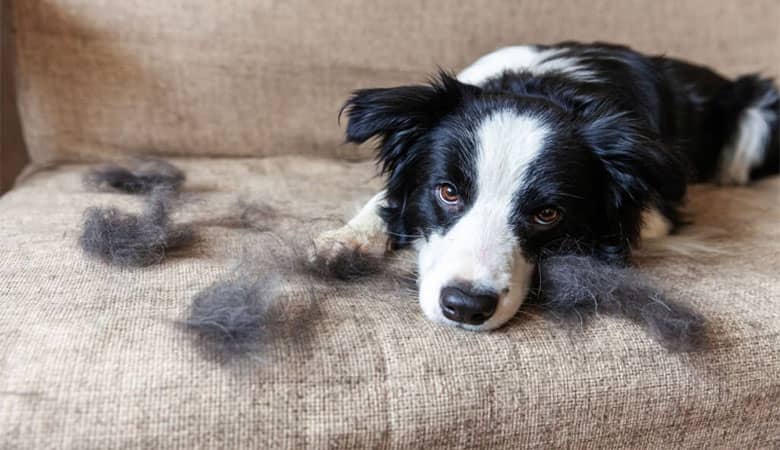Hair loss in dogs is a common issue. Whether nutritional deficiencies or an allergy causes it, there are steps you can take to help your furry friend.
Hair loss can be a frustrating problem for many dog owners.
Hair loss can be a frustrating problem for many dog owners. Hair loss from your dog’s skin is a common side effect of many medical conditions, including thyroid disease and diabetes mellitus. However, dogs also have several other causes of hair loss—and not just on the head! It’s important to know what causes your pet’s poor health so you can make sure that he stays as healthy as possible!
- Alopecia (hairless patches) is when some parts of an animal’s body do not have any hair; this condition happens when follicles stop producing new cells because they become damaged or destroyed by illness or injury. For example, if one follicle becomes inflamed due to infection or autoimmune disease (such as lupus), it will no longer produce new hairs but continue producing old ones instead.* *Alopecia isn’t just found in humans; it can affect any mammal with fur coats.*
Finding the cause of your dog’s hair loss
Hair loss is a common problem. It can be caused by various things, including poor nutrition or exercise, skin diseases such as flea allergy dermatitis (FAD), thyroid problems and anemia.
Once you’ve ruled out the causes mentioned above for your pet’s hair loss and they still have noticeable amounts of bald patches or thinning fur on their body, it’s time to visit the vet for further diagnosis.
Your vet will likely perform blood tests to determine if any underlying medical conditions are causing this issue in your pup. If there are no obvious signs of illness or disease present, then it’s likely that diet may be playing a role in causing their shedding habits; however, if other factors are at play, this could mean something else entirely!
When should you be worried?
If your dog has bald patches or significant hair loss, it’s time to take action. If your dog is scratching excessively, losing hair around the mouth and face, and losing hair on the ears, feet, tail or hindquarters, then you should start looking for possible causes of the problem.
Other conditions that may cause baldness to include:
- Skin disorders such as eczema (itching) and inflammatory lesions
- Hairless dogs with genetic diseases such as mange mites
Consulting with your veterinarian
You should consult a veterinarian if your dog has been diagnosed with hair loss. A physical exam will be performed to rule out other causes of the problem and determine if any underlying medical problem may be causing it. The vet may also recommend treatment for this condition depending on what they find during their examinations and tests.
Diagnosing and treating dog hair loss
Hair loss is common when your dog’s hair does not grow back. In most cases, the cause of hair loss can be determined and treated by a veterinarian.
For example, suppose your dog has developed alopecia (hair loss) due to an underlying medical condition such as hypothyroidism or diabetes mellitus. In that case, it’s important to get him checked out by a vet immediately so you can start treatment as soon as possible.
Suppose your dog’s alopecia isn’t due to an underlying condition and doesn’t improve after several weeks of treatment with prescription medicine at home. In that case, it might be caused by allergies or poor nutrition—and you’ll need to feed him better-quality food until his skin clears up!
Treatment for dog hair loss depends on the cause
- Dietary changes
- Allergy testing
- Antibiotics
- Steroids
For some dogs, excessive hair loss may be due to diet or other allergies, which can be corrected.
You might be surprised to learn that diet can cause hair loss and allergies. This is because some dogs are sensitive to certain foods or ingredients, which increases the likelihood of shedding. If your dog suffers from a dietary allergy, it’s best to consult its veterinarian before making any changes in how they eat.
The most common causes of excessive hair loss in dogs include:
- Medication side effects – Some medications can cause dandruff-like patches on your pet’s skin and fur; this is especially true if there was a change in the dosage schedule or if you have switched from one type of medication (such as flea prevention) to another (such as heartworm prevention).
It’s essential for owners who notice this symptom to talk directly with their vet about what might be happening so they can determine whether further action would be necessary based on these findings.
Conclusion
Hair loss can be a frustrating problem for dogs and their owners. For some dogs, excessive hair loss may be due to diet or other allergies, which can be corrected. In most cases, the cause of your dog’s hair loss is unknown. If you’re concerned about your pet’s condition, consult with your veterinarian as soon as possible so that they can help determine if it’s severe enough to warrant treatment.

